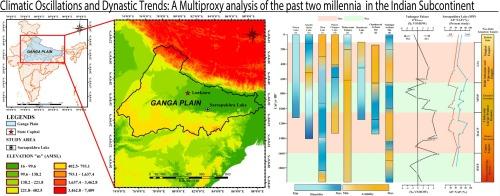Climatic Oscillations and Dynastic Trends: A Multiproxy analysis of the past two millennia in the Indian Subcontinent
IF 5.4
1区 农林科学
Q1 GEOSCIENCES, MULTIDISCIPLINARY
引用次数: 0
Abstract
The study examines centennial-scale climatic oscillations over the past two millennia in the monsoon-dominated Indian subcontinent by multiproxy analysis of pollen along with stable carbon isotope, total organic carbon, magnetic susceptibility, and grain size from a 274 cm deep sediment profile in Sarsapukhra Lake, Varanasi, in the Central Ganga Plain (CGP) to portray vegetation changes and their impact on rise and fall of dominant dynasties. Between ∼1800 to 1600 cal yr BP, the coarser silty sand with few Poaceae and Asteraceae pollen with other proxy data, indicate that the region experienced a strong Indian Summer Monsoon (ISM). Subsequently, from ∼1600 to 1350 cal yr BP, presence of mixed moist deciduous taxa such as Shorea robusta, Madhuca indica, Rubiaceae, Morus alba, Syzygium, and Moraceae indicate a moderate ISM while between 1350 to 1200 cal yr BP, the dominance of dry deciduous taxa viz. Acacia sp., Bombax ceiba, Holoptelea, Rutaceae, Madhuca indica, Mangifera indica etc. suggested weak ISM conditions. A pulsative ameliorating trend from ∼1200 to 1030 cal yr BP showed the dominance of deciduous taxa such as Holoptelea, Rutaceae, Ziziphus, Rubiaceae, Maytenus and Acanthaceae etc. indicating warm and moist climatic conditions, followed by a weak ISM until ∼900 cal yr BP and improved ISM until 620 cal yr BP. Subsequently, an improving trend in the ISM from ∼620 to 450 cal yr BP was observed, with increased dominance of wetland taxa, followed by acute dry climate beyond ∼450 cal yr BP indicating poor ISM conditions.
Additionally, the alternating warm and cold episodes had a direct impact on vegetation, forcing human civilizations to migrate from their original locations and contributing to the downfall of prominent dynasties. Furthermore, this study lays the foundation for future research into issues related to vegetation change, the amount of ISM shift, and human culture−climate relationship.

气候振荡与王朝趋势:对印度次大陆过去两千年的多代理分析
该研究通过对来自恒河平原中部瓦拉纳西萨萨普拉湖(Sarsapukhra Lake)274 厘米深沉积剖面的花粉以及稳定碳同位素、总有机碳、磁感应强度和粒度的多代理分析,研究了过去两千年来季风主导的印度次大陆百年尺度的气候振荡,以描绘植被变化及其对主导王朝兴衰的影响。在公元前 1800 至 1600 年期间,较粗的淤泥质沙土中含有少量的禾本科和菊科花粉,加上其他代用数据,表明该地区经历了强烈的印度夏季季风(ISM)。随后,在公元前 1600 年至公元前 1350 年期间,出现了混合潮湿落叶类群,如娑罗双树、枫香树、茜草科、白桑树、茜草科和桑科,这表明该地区经历了中度的印度夏季季风(ISM)、Bombax ceiba、Holoptelea、芸香科、Madhuca indica、Mangifera indica 等干燥落叶类群占优势,表明 ISM 条件较弱。从公元前 1200 年至公元前 1030 年,ISM 呈脉冲式改善趋势,落叶类群占主导地位,如 Holoptelea、芸香科、紫薇属、茜草科、五月茄属和刺桐科等,表明气候条件温暖湿润。此外,冷暖交替对植被产生了直接影响,迫使人类文明从原址迁徙,并导致了著名王朝的衰落。此外,这项研究还为今后研究植被变化、ISM变化量以及人类文化与气候关系等相关问题奠定了基础。
本文章由计算机程序翻译,如有差异,请以英文原文为准。
求助全文
约1分钟内获得全文
求助全文
来源期刊

Catena
环境科学-地球科学综合
CiteScore
10.50
自引率
9.70%
发文量
816
审稿时长
54 days
期刊介绍:
Catena publishes papers describing original field and laboratory investigations and reviews on geoecology and landscape evolution with emphasis on interdisciplinary aspects of soil science, hydrology and geomorphology. It aims to disseminate new knowledge and foster better understanding of the physical environment, of evolutionary sequences that have resulted in past and current landscapes, and of the natural processes that are likely to determine the fate of our terrestrial environment.
Papers within any one of the above topics are welcome provided they are of sufficiently wide interest and relevance.
 求助内容:
求助内容: 应助结果提醒方式:
应助结果提醒方式:


